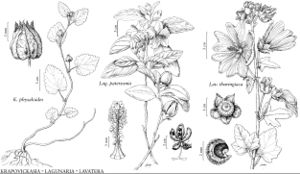Lagunaria
Consp. Regn. Veg., 202. 1828/1829.
| Taxon | Illustrator ⠉ | |
|---|---|---|
 | Krapovickasia physaloides Lagunaria patersonia Lavatera thuringiaca | Linny Heagy Linny Heagy Linny Heagy |
Trees, evergreen. Stems erect; bark gray, smooth; twigs stellate-hairy and with peltate scales, glabrescent. Leaves: stipules deciduous, inconspicuous, filiform; blade ovate, unlobed, base rounded, margins entire. Inflorescences axillary, solitary flowers; involucel cuplike, bractlets persistent or deciduous, 3–5, often obscure or suppressed, connate basally. Flowers: calyx not accrescent, not inflated, lobes unribbed, wide-ovate, apex acute to rounded or irregularly lacerate; corolla wide-campanulate, pink to rose-pink, fading white; staminal column exserted; ovary 5-carpellate; ovules (3–) 5–10 per locule; style not branched; stigmas club-shaped. Fruits capsules, erect to pendulous, ovate, 5-locular, somewhat indurate-chartaceous, brown stellate-hairy covered with fine spicules, filled with irritant hairs reminiscent of fiberglass. Seeds (3–) 5–10 per locule, glabrous.
Distribution
Introduced; Calif., Pacific Islands (Lord Howe Island), Pacific Islands (Norfolk Island), e Australia
Discussion
Species 1 or 2 (1 in the flora).
The pinnately veined leaves of Lagunaria are exceptional for the family. The Queensland, Australia, population has recently (2006) been reclassified as L. queenslandica Craven, but there is controversy about its distinctness.
Selected References
None.
Lower Taxa
"fine" is not a number.